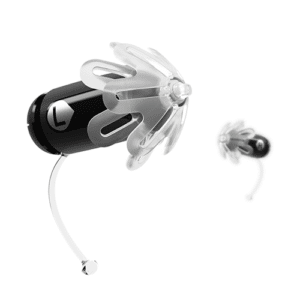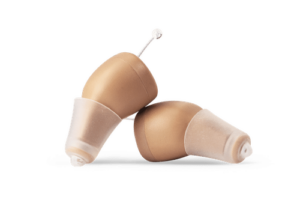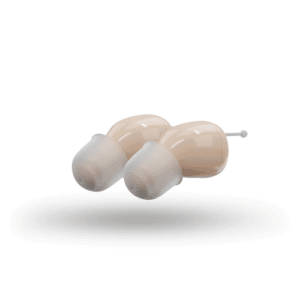Eargo is considered a top-of-the-line OTC brand for people who want a tiny, invisible hearing aid. When fully inserted, it can hardly be seen by other people. Eargo devices also include automatic sound adjustments, Bluetooth connectivity to an app, and water resistance, making them our choice for the “Best OTC” invisible hearing aid.
Best Invisible Hearing Aids of 2025: Which Are the Smallest?
Best Invisible Hearing Aids: Key Takeaways
- The smallest hearing aids are so tiny no one can tell you’re wearing them.
- The best invisible hearing aids range from $297 per pair for basic devices to more than $7,000 for top-of-the-line hearing aids.
- Invisible hearing aid styles are available from both over-the-counter (OTC) and prescription hearing aid manufacturers.
- Our top three discreet hearing aids are Eargo, a great OTC option with high-quality technology, MDHearing NEO and NEOX, for their affordability and free remote audiology care, and the Audien Hearing Atom Pro, which has the lowest price of all rechargeable hearing aids.
- Potential drawbacks of invisible hearing aids include shorter battery life, fewer advanced features, and the possibility of feedback issues.
Hearing aids can be life-changing for people with hearing loss. But not everyone feels comfortable wearing a device behind their ear that other people can see. If that describes you, take a look at our review for some of the smallest hearing aids on the market.
We’ve hand-tested and researched dozens of devices to help you find the best discreet hearing aid for your needs and budget. Read on to learn about prices, features, and customer support available with invisible hearing aids.
Our top picks of the best invisible hearing aids
Invisible hearing aids comparison
| Price per pair | $799–$2,950 | $297–$397 | $249 | $3,500–$4,000 | $1,540–$5,545 | $2,150–$5,945 |
| Type | OTC | OTC | OTC | Prescription | Prescription | Prescription |
| Hearing aid style | Completely-in-canal | Completely-in-canal | Completely-in-canal | Invisible-in-canal | Invisible-in-canal | In-the-ear, completely-in-canal, invisible-in-canal |
| Battery type | Rechargeable | Rechargeable | Rechargeable | Disposable | Disposable | Disposable |
| Bluetooth | Yes (adjustments only, no streaming) | No | No | No | Yes (adjustments only, no streaming) | Yes |
| Adjustments | Phone app or remote support | Buttons on the hearing aid | With company-provided screwdriver | Audiologist or remote control | Phone app, remote support, in-person, or remote control | Phone app, remote support, and in-person |
| Warranty | 1–2 years | 1 year | 1 year | Depends on retailer | Depends on retailer | Depends on retailer |
Best invisible hearing aids review
What is an invisible hearing aid?
Invisible hearing aids are styles and designs others can’t see when properly fitted. Both completely-in-canal (CIC) and invisible-in-canal (IIC) hearing aids fit entirely in the ear canal, making them unnoticeable to other people.
Invisible hearing aids are great for people who want a discreet device others won’t see. Because in-canal styles are smaller than other devices, not all can accommodate certain technologies, like rechargeable batteries, telecoil, and Bluetooth streaming. Eargo, for example, has a rechargeable battery but no telecoil or Bluetooth streaming ability.
Pros and cons of invisible hearing aids
Bottom line
Invisible hearing aids are a great choice for people who don’t want others to know they’re wearing them. But they come with a few drawbacks—notably, a shorter battery life and fewer features than RIC and BTE hearing aids. Devices behind the ear also tend to produce less feedback than those in the ear.
But if you’re willing to make those concessions and are looking for the smallest hearing aids on the market, an invisible hearing aid may be just what you want.
Frequently asked questions
The most discreet hearing aid is the Phonak Lyric, which sits all the way in your ear canal, completely hidden from view.
Invisible hearing aids typically include fewer features and a shorter battery life compared to BTE or RIC hearing aids.
Invisible hearing aids have benefited from advances in sound technology and features in the past 10 years, making them as effective as other styles at treating hearing loss.
Have questions about this review? Email us at reviewsteam@ncoa.org.
Sources
- NCOA Hearing Aids Survey. 600 respondents. Conducted using Pollfish. Launched March 2022










